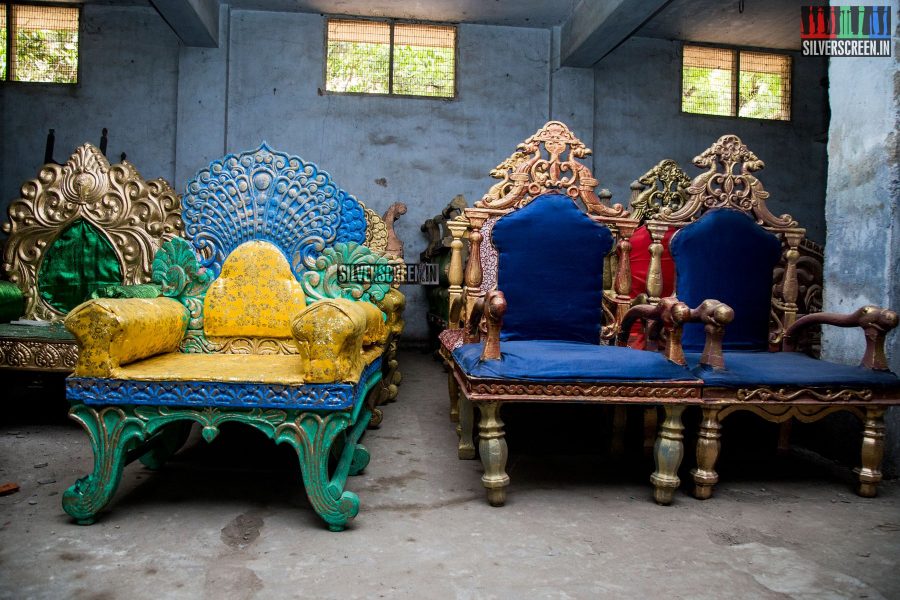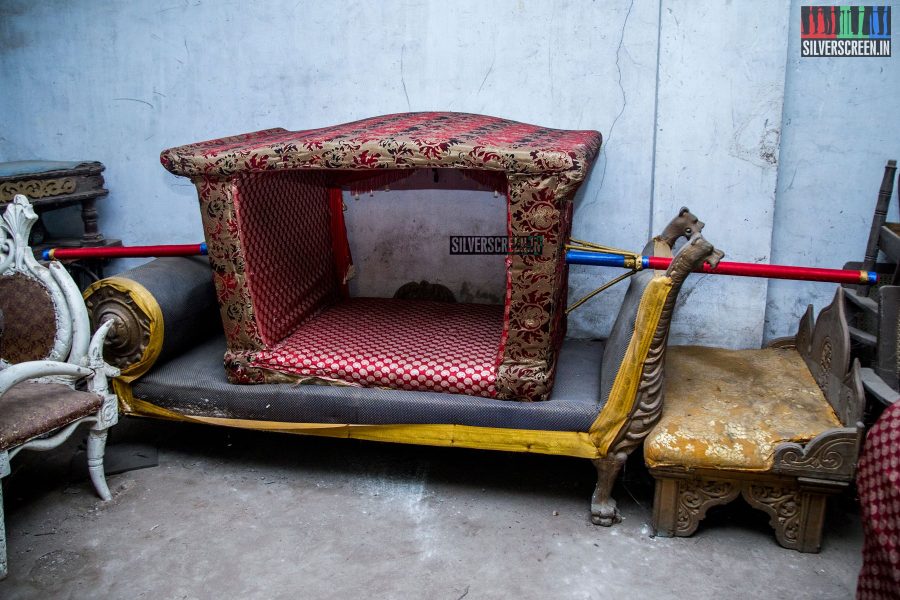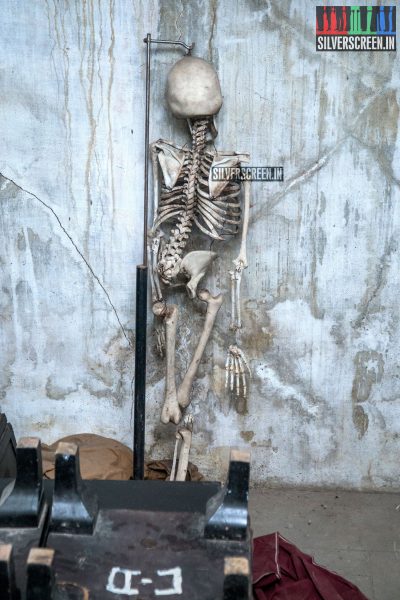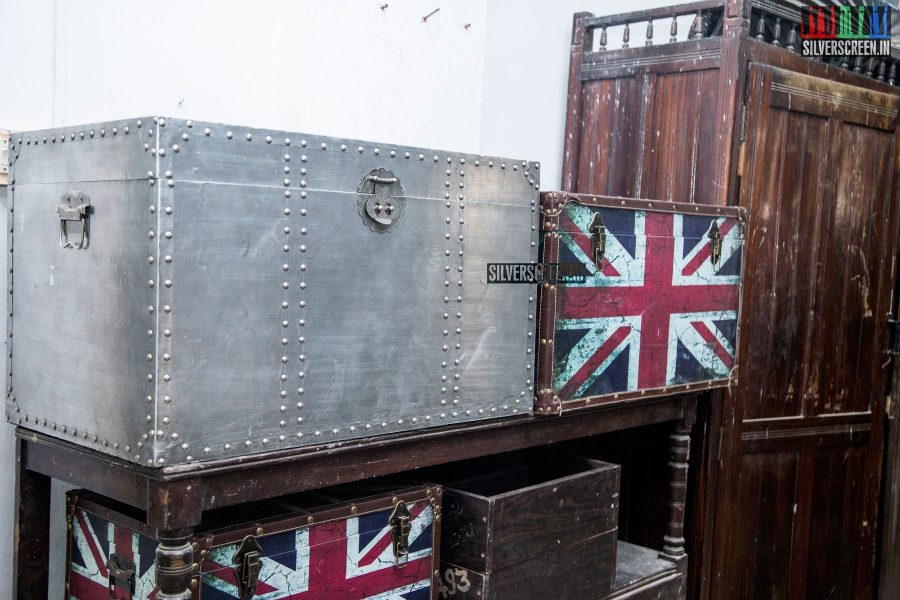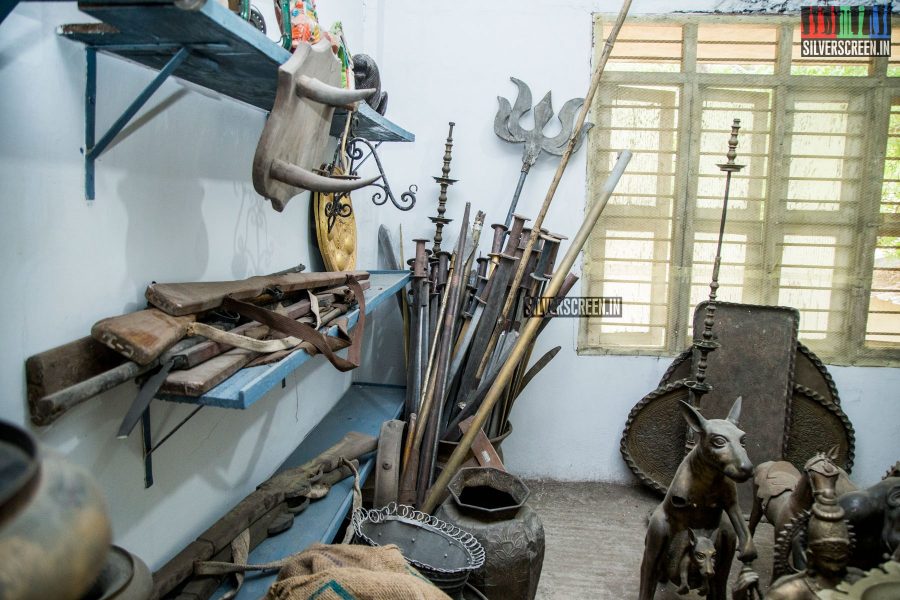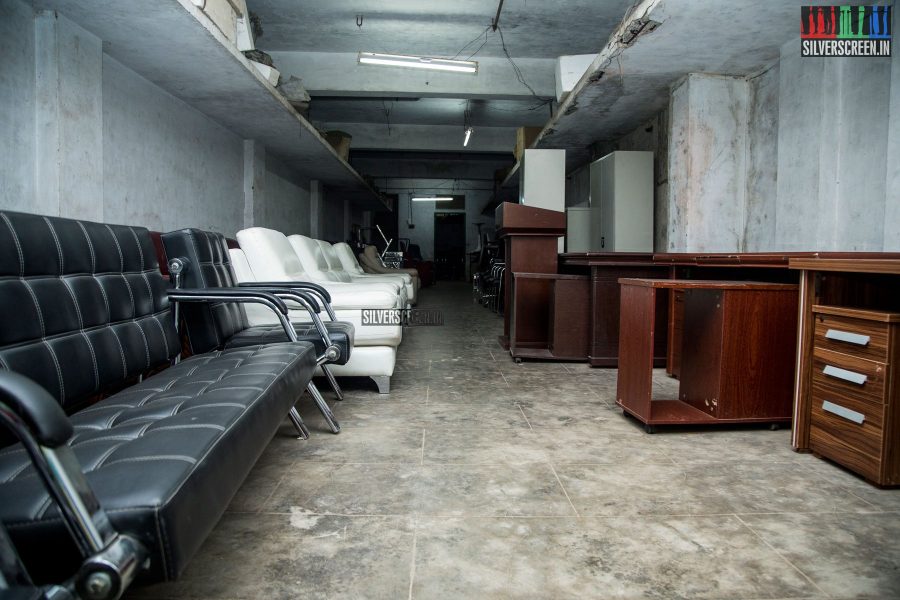Tucked away in a corner of a busy Kodambakkam street is a sleepy compound. Just inside is the old, nondescript warehouse. A heavy-eyed dog snoozes on the courtyard. A hen ambles around; an occasional cluck the only disruption in the silence. Faded letters are etched on a marble nameplate at the gate: Azeem Cine Decors. I step inside. This is where the world of Kollywood’s timeless classics were meticulously hammered into place.
1952 was a time when Madras was the hub of filmmaking in South India. The major Madras studios had established themselves. This was the year that Mohammed Azam founded ‘Cine Crafts’ (now Azeem Cine Decors), the store that pioneered the business of cinema prop rentals in South India. When art directors from an MGR or Shivaji film wanted props, for an everyday scene or an elaborate set for a mythological film, this is where they came.
*****
“Sir is taking a nap. Please wait,” I am told. Mohammed Azeem, son of Azam and the current proprietor of the store, lives in the house upstairs with his family. His son, Abid, handles the daily business. Azeem has retired, and peacefully presides over the store.
 When we finally meet, Azeem starts talking in a wavering, yet firm voice about how it all started, “It was a new business concept. I guess someone suggested it to him [Azam]. “Our first film was,” he pauses and turns to his son with searching eyes. “Parasakthi,” responds Abid immediately. It began as a modest handicrafts shop on Mount Road; then expanded to cater to the needs of Madras’ flourishing film industry. In the early 70s, the family moved to the compound in Kodambakkam.
When we finally meet, Azeem starts talking in a wavering, yet firm voice about how it all started, “It was a new business concept. I guess someone suggested it to him [Azam]. “Our first film was,” he pauses and turns to his son with searching eyes. “Parasakthi,” responds Abid immediately. It began as a modest handicrafts shop on Mount Road; then expanded to cater to the needs of Madras’ flourishing film industry. In the early 70s, the family moved to the compound in Kodambakkam.
They have been a part of countless films, including landmark ones like Vasanthamaligai, Sakalakala Vallavan, Samsara Sangeetham, Padaiyappa, Baasha, Thevar Magan, Thenali, Minsarakkanavu, and Ninaithale Inikum. More recently, they worked for the sets Vijay’s Theri and Shankar’s 2.0, and Vijay’s next film.
*****
The family’s roots are in Punjab. They shifted to Chennai, then Madras, before the partition. “Those were the days of studios. Vijaya Vahini, AVM, Prasads, Shyamala Studios, Majestic, MGR’s Satya Studio, Karppagam. Most of the movies were based on stories from puranas and mythology. We would supply the furniture and props for durbar halls and palaces,” recalls Azeem.
A range of durbar furniture, palanquin, and a peacock mirror occupy one corner of the warehouse. “Dad thought these things had become useless. But I told him that they would never go out of demand. Sure enough, these antiques are the ones used most frequently,” says Abid.
*****
“Being the only son, I joined my father’s business at an early age. I had no other interests,” says Azeem. “Those days we used to make furniture and properties, not buy it. Art directors would give us sketches, designs, and catalogues. We had a lot of carpenters, painters, and liners working for us.” He points towards the warehouse outside, “Right here, they used to work.”
He continues, “In the 60s, we used to supply costumes too. For Raja-Rani, policemen, folk dancers. We would go to Karaikudi, Mysore, Hyderabad, and Kolkata, to pick up original antique furniture. Nowadays all we have are replicas. Not the original ones. We used to be really busy in those days.” Azeem’s father and his team would go to the shooting location and see their work. They would have intensive discussions with the film’s art director. When Azeem took over the business, he followed the practice.
But as the studio culture began to die out, things changed. Azeem says thoughtfully, “I kind of miss those days. A little. Not much.” He shows me a room full of contemporary style furniture. Furniture for homes, offices, and even cafes and restaurants are here. “Nowadays, we import furniture from China. The costs are substantially less that way. Business deals, these days, are forged over Whatsapp messages,” he laughs. “The art directors send their demands on Whatsapp. This guy [indicates his son] replies with pictures of the props we have.”
*****
 Azeem considers Vasanthamaligai their biggest work. “It was a very peculiar movie. The story demanded a different kind of set. The film revolved around that.” There was plenty of interesting work those days, he says, “Sakalakala Vallavan was a work we really enjoyed doing.”
Azeem considers Vasanthamaligai their biggest work. “It was a very peculiar movie. The story demanded a different kind of set. The film revolved around that.” There was plenty of interesting work those days, he says, “Sakalakala Vallavan was a work we really enjoyed doing.”
“Now, technology has improved tremendously. Everything has improved, in fact. The young generation of actors and film makers are excellent. Those days, they used to take their time in doing things. They used to plan; one week or 10 days in advance. These days, they come in the evening and look for props for the next morning’s shoot. They pick up whatever is available. They say that the film is focused on the artistes and not the props,” says Azeem. He adds, “Earlier, they were very particular about the sets.”
“MGR was very keen about the production design part. If the furniture didn’t match the colour of the background, he would notice. He would say, ‘What is this, who is the art director? Call him!’ Shivaji sir, though, concentrated only on the acting part.”
His favourite actor is Shivaji, but he’s quick to add, “Of course MGR too. He was more of a mass actor.” His favourite director is Sridhar, “He [Sridhar] remade Rajendra Kumar’s Dharti in Tamil, as Sivantha Mann with Shivaji. That’s my all-time favourite. Also, one of Sridhar’s comedy movies, Kadhalikka Nermillai.”
Shivaji Ganesan was a close friend of Azeem’s family, “We used to work in Hindi and Malayalam movies too. That’s how my father was friends with stars like Raj Kapoor and Dilip Kumar.” He proudly points to a black-and-white photograph displayed in his office, “Look! That’s my dad with Dilip Kumar.” We talk about how his family briefly tried their hand at movie production in the 80s.
*****
 When he learns that I’m from Kerala, Azeem casually remarks, “My cousin’s daughter is married to a Malayalam actor’s son. A very cute boy.” Turns out he’s talking about Mammootty’s son, Dulquer Salman.
When he learns that I’m from Kerala, Azeem casually remarks, “My cousin’s daughter is married to a Malayalam actor’s son. A very cute boy.” Turns out he’s talking about Mammootty’s son, Dulquer Salman.
As we continue our tour of the warehouse, some people arrive. One of them is the art director from the sets of Karthi’s latest movie Kashmora. They take a look at the indoor antiquities, and compare them with their list. “Azeem’s is the place for furniture and indoor properties. They are the oldest, and the most reliable,” says the art director.
Abid smiles, “We don’t have a nameboard outside this place. Yet, there’s no dip in business. We don’t go to the production crew, they always come to us.”
*****








